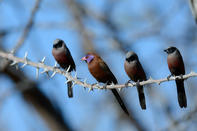
A total of nine species of waxbill are found in South Africa, all falling under the family of Estrildidae. The swee waxbill is endemic and the violet-eared is a near-endemic.
Waxbills earned their name from the small waxy layers of keratin that are exfoliated from the base of their bills. The conical bills evolved for cracking and husking seeds, before swallowing.
The waxbill's flight is a rapid undulating flight, using wings that are short and rounded. Most waxbills spend the majority of their day on the ground foraging, often in mixed flocks. Outside of the breeding season, small flocks or family groups will roost very close together in cold weather.
 Black-faced waxbill have grey-brown heads and backs and barred wings. They have deep crimson rumps. This wax bill has a black face, with bla...
Black-faced waxbill have grey-brown heads and backs and barred wings. They have deep crimson rumps. This wax bill has a black face, with bla... The blue waxbill has a pale blue belly, rump and upper chest, extending on to the face. The back, crown and back of the head are light brown...
The blue waxbill has a pale blue belly, rump and upper chest, extending on to the face. The back, crown and back of the head are light brown... The violet-eared waxbill is one of the most colourful seed eaters found in South Africa. This waxbill has violet cheeks, a red bill and a bl...
The violet-eared waxbill is one of the most colourful seed eaters found in South Africa. This waxbill has violet cheeks, a red bill and a bl...